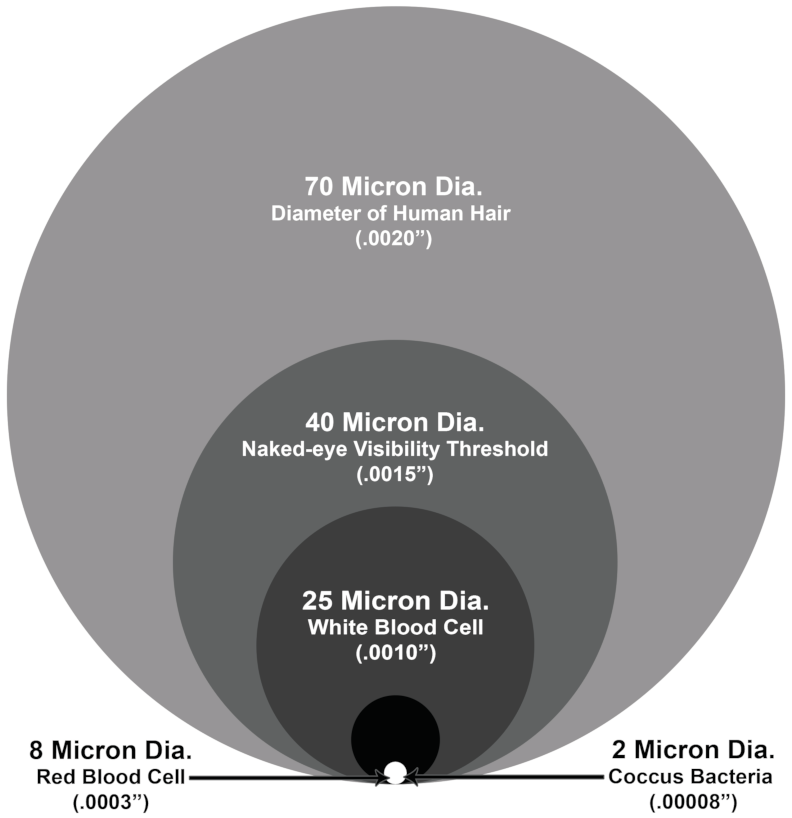Mesh and Micron Sizes
 What is a micron?Micron is the measure of length most frequently used to describe tiny particle sizes. The term micron is actually a commonly used shorthand for micrometer (American spelling) or micrometre (international spelling). The official symbol for the micron or micrometer is μm, sometimes simplified as um. A micron is defined as one-millionth of a meter, a little more than one twenty-five thousandth of an inch.
What is a micron?Micron is the measure of length most frequently used to describe tiny particle sizes. The term micron is actually a commonly used shorthand for micrometer (American spelling) or micrometre (international spelling). The official symbol for the micron or micrometer is μm, sometimes simplified as um. A micron is defined as one-millionth of a meter, a little more than one twenty-five thousandth of an inch.
Note: ISM offers fluid, gas and air flow management components some of which contain filter mesh as a component part. ISM does not offer mesh itself and is unable to source or provide it.
What does mesh size mean?Mesh size is referring to the mesh number (a US measurement standard) and its relationship to the size of the openings in the mesh and thus the size of particles that can pass through these openings. Figuring out the mesh number is simple. All you do is count the number of openings in one linear inch of screen. This count is the mesh number. A 4-mesh screen means there are four little square openings across one inch of screen. A 100-mesh screen has 100 openings per inch, and so on.
As the number indicating the mesh size increases, the size of the openings and thus the size of particles captured by the screen decreases. Higher mesh numbers = smaller particle sizes. It is very important to remember that mesh size is not a precise measurement of the mesh opening size. This is because screens can be made with different materials with different thicknesses of strands or wire. The thicker the strands, the smaller the openings that a particle can pass through, and vice versa.
Also keep in mind that mesh is a two-dimensional sheet and the actual 3D shapes of particles vary dramatically. A good example of this is the diameter of a hair versus its length. Particles can also be elastic amalgams or clumps of mixed materials that can deform and squeeze through mesh openings.
How fine do screens get?This depends on the thickness of the wire or strand used to make the mesh. Most ISM flow control components do not contain filter screens any finer than 500 mesh. The primary reason for this is that as the mesh number rises, the space between the wires or strands becomes smaller. At some point the mesh number becomes so high that the percentage of open area is too low to be useful. This point is usually somewhere between 450 and 700 mesh depending on the diameter of the wire or filament used.
Note: Beyond 325 to 400 mesh, particle size is normally described only in microns.
Download Our Mesh & Microns eBook
| US Mesh* | Microns | Inches | Millimeters |
|---|---|---|---|
| 35 | 500 | 0.0197 | 0.5 |
| 40 | 400 | 0.0165 | 0.4 |
| 45 | 354 | 0.0138 | 0.354 |
| 50 | 297 | 0.0117 | 0.297 |
| 60 | 250 | 0.0098 | 0.25 |
| 70 | 210 | 0.0083 | 0.21 |
| 80 | 177 | 0.007 | 0.177 |
| 100 | 149 | 0.0059 | 0.149 |
| 120 | 125 | 0.0049 | 0.125 |
| 140 | 105 | 0.0041 | 0.105 |
| 170 | 88 | 0.0035 | 0.088 |
| 200 | 74 | 0.0029 | 0.074 |
| 230 | 63 | 0.0025 | 0.063 |
| 270 | 53 | 0.0021 | 0.053 |
| 325 | 44 | 0.0017 | 0.044 |
| 400 | 37 | 0.0015 | 0.037 |
| 450 | 32 | 0.0013 | 0.032 |
| 500 | 25 | 0.0010 | 0.025 |
| 635 | 20 | 0.0008 | 0.020 |
*Values are based on the American National Standard for Industrial Wire Cloth (American Standard ASTM - E 11).
Download Our Mesh & Microns eBook

